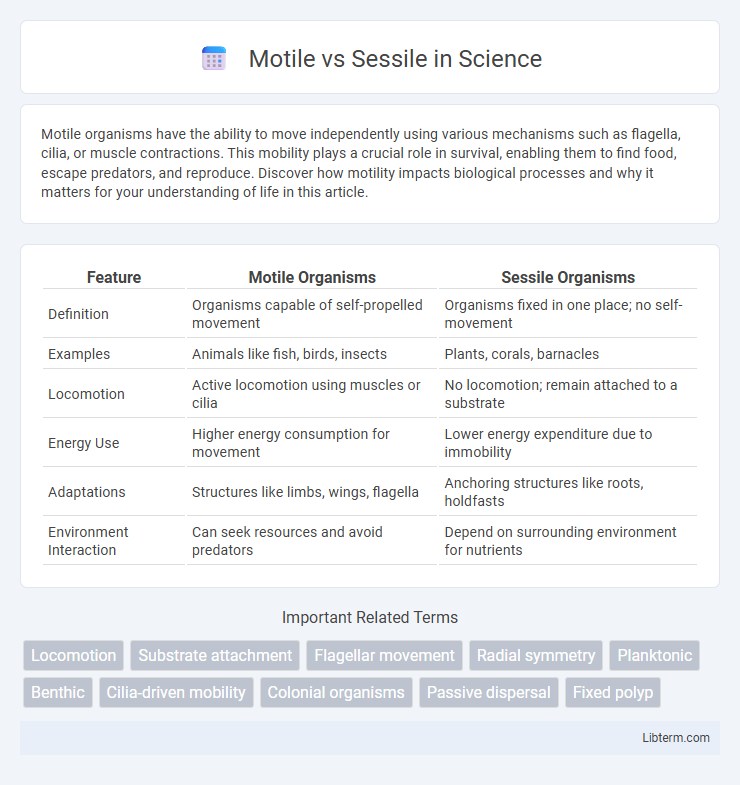Motile organisms have the ability to move independently using various mechanisms such as flagella, cilia, or muscle contractions. This mobility plays a crucial role in survival, enabling them to find food, escape predators, and reproduce. Discover how motility impacts biological processes and why it matters for your understanding of life in this article.
Table of Comparison
| Feature | Motile Organisms | Sessile Organisms |
|---|---|---|
| Definition | Organisms capable of self-propelled movement | Organisms fixed in one place; no self-movement |
| Examples | Animals like fish, birds, insects | Plants, corals, barnacles |
| Locomotion | Active locomotion using muscles or cilia | No locomotion; remain attached to a substrate |
| Energy Use | Higher energy consumption for movement | Lower energy expenditure due to immobility |
| Adaptations | Structures like limbs, wings, flagella | Anchoring structures like roots, holdfasts |
| Environment Interaction | Can seek resources and avoid predators | Depend on surrounding environment for nutrients |
Introduction to Motile and Sessile Organisms
Motile organisms possess the ability to move independently using structures like flagella, cilia, or muscular tissues, allowing them to seek food, escape predators, or find suitable habitats. Sessile organisms, in contrast, remain fixed in one place throughout their life, often attaching themselves to surfaces such as rocks or aquatic plants, relying on water currents or other external forces for nutrient acquisition. The distinction between motile and sessile forms plays a crucial role in ecological dynamics, influencing feeding strategies, reproduction, and survival mechanisms.
Defining Motility in Living Systems
Motility in living systems refers to the intrinsic ability of organisms or cells to move independently using energy-consuming processes like flagellar rotation, ciliary beating, or cytoskeletal rearrangements. Motile organisms, such as bacteria, protozoa, and certain animal cells, exhibit active movement allowing them to seek nutrients, escape predators, or migrate during development. In contrast, sessile organisms remain fixed to a substrate, relying on passive mechanisms like water or air currents for nutrient acquisition and dispersal.
Characteristics of Sessile Organisms
Sessile organisms are characterized by their fixed position, lacking the ability to move from place to place, which often results in specialized adaptations for attachment, such as root-like structures or adhesive secretions. These organisms typically rely on passive means for feeding and reproduction, including filter feeding or spawning, minimizing energy expenditure associated with locomotion. Sessility is common in various aquatic species like barnacles, corals, and sponges, where maintaining a stable position enhances nutrient uptake and survival in dynamic environments.
Evolutionary Advantages of Motility
Motility provides significant evolutionary advantages by enabling organisms to actively seek resources, escape predators, and colonize new environments, increasing their survival and reproductive success. Motile species exhibit enhanced adaptability through movement strategies like chemotaxis and phototaxis, which optimize nutrient acquisition and habitat selection. The ability to relocate also promotes genetic diversity via migration and mating opportunities, driving evolutionary innovation and resilience.
Ecological Roles of Sessile Species
Sessile species, such as corals, barnacles, and sponges, play a crucial ecological role by forming stable habitats that support diverse marine biodiversity and enhance ecosystem productivity. Their fixed positions enable the creation of complex structures that provide shelter and breeding grounds for numerous motile species, thereby promoting ecological interactions and nutrient cycling. Sessile organisms also contribute to water filtration and substrate stabilization, which maintain ecosystem health and resilience in aquatic environments.
Adaptations Supporting Movement
Motile organisms possess specialized adaptations such as flagella, cilia, and muscular limbs that facilitate active movement to seek food, escape predators, and find mates. Sessile organisms have evolved structures like holdfasts, adhesive secretions, and flexible stalks enabling them to maintain position and withstand environmental forces without relocating. These contrasting adaptations highlight evolutionary strategies for survival in dynamic versus stable habitats.
Survival Strategies of Sessile Life Forms
Sessile life forms enhance survival by developing specialized adaptations such as robust attachment structures and efficient nutrient absorption mechanisms that allow them to thrive in stable environments. Their stationary nature promotes energy conservation and reliance on environmental resources like water currents for food and reproduction. These strategies ensure long-term persistence despite limited mobility in dynamic ecosystems.
Examples of Motile vs. Sessile Organisms
Motile organisms, such as birds, fish, and cheetahs, exhibit movement by using limbs, fins, or specialized muscles to navigate their environment actively. Sessile organisms, including sponges, barnacles, and corals, remain fixed in one place, often anchoring themselves to substrates like rocks or ocean floors. These contrasting modes of existence reflect adaptations suited to their ecological niches and survival strategies.
Impacts on Ecosystems and Biodiversity
Motile organisms, capable of movement, enhance ecosystem connectivity by facilitating gene flow and species dispersal, which supports genetic diversity and resilience. Sessile organisms, anchored in one place, create stable habitats that promote niche specialization and provide critical resources for other species, fostering localized biodiversity. The interplay between motile and sessile species maintains ecosystem balance, influencing energy flow, nutrient cycling, and community structure.
Future Research and Applications
Future research on motile and sessile organisms is expected to enhance understanding of cellular mechanisms governing movement and adhesion, offering breakthroughs in regenerative medicine and targeted drug delivery. Emerging applications include bioengineered tissues capable of dynamic responses and novel biomaterials inspired by sessile biofilms for environmental remediation. Advanced imaging and genetic tools will drive innovations in manipulating motility pathways for therapeutic interventions and synthetic biology.
Motile Infographic

 libterm.com
libterm.com